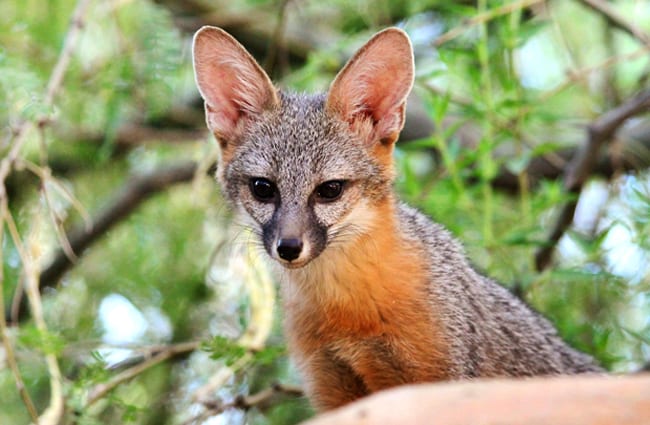The Kit Fox is a fox species that lives in southwest North America. Along with the rest of the true foxes, researchers place the Kit Fox (we’ll call them the “Kit”) in the taxonomic genus Vulpes. Some of their relatives include Arctic foxes, Red Foxes, Fennec Foxes, Swift Foxes and more.
One subspecies of this fox, the San Joaquin Kit Fox, has declining populations and is in danger of extinction. Read on to learn about the Kit Fox.
Description of the Kit Fox
The Kit Fox is the smallest species of fox in North America. In fact, it is the smallest canine species in North America. They are about a foot and a half long, and weigh about four or five pounds.
Like most foxes, Kits have large ears which, at their longest, measure nearly four inches long. Their fur is usually tan or grey, and they are normally darker on their back and lighter on their underbellies.
Interesting Facts About the Kit Fox
This fox species has several different adaptations that help it survive. Learn more about their unique traits below.
- Heat Release – While large ears are useful for hearing prey, they also serve another purpose. The southwest is a hot region, and though Kits don’t have quite as impressive ears as fennec foxes, they do serve a similar purpose. Larger ears help the foxes release heat from their bodies, because more blood vessels pass close to the open air, which cools the blood within.
- Feeding Habits – When it comes down to it, sometimes you just can’t beat the heat. This is one of the primary reasons why Kit Foxes are nocturnal, or active after dark. They hide in their shady underground dens and avoid the heat of the day, then emerge at night to hunt for food.
- Familial Assistance – Sometimes young Kits aren’t quite ready to leave their parents. It is not unusual for members of the previous year’s litter to stay with their parents and help feed the new kits (babies). Mom and Dad are more than happy to accept a helping hand, and the yearling foxes get to keep learning hunting skills.
- No Love Lost Between Cousins – The Kit Fox’s distant cousin is one of its most dangerous foes. Coyotes, which are also members of the Canidae family, are the primary predator of these little foxes. In fact, coyotes kill more Kits than any other predator.
Habitat of the Kit Fox
These little foxes range through arid and semi-arid regions in the southwest. They inhabit a number of different ecosystems within their range, including deserts, desert edges, chaparral, scrub, savanna, grassland, sand dune, and more.
Some Kits also range into manmade habitats, and like red foxes they range into some urban areas like suburbs, farms, and agricultural regions. These habitats attract rodents, which the foxes hunt for food.
Distribution of the Kit Fox
This species lives in North America, from the United States into Mexico. The northernmost extent of their range extends all the way to Oregon, and they also live through California, Colorado, Utah, Nevada, New Mexico, Arizona, and some surrounding areas.
Their range extends into central Mexico in Chihuahua and Coahuila, as well as Baja California. Their populations are common in some regions, and rarer in others.
Diet of the Kit Fox
These little foxes are primarily carnivorous and eat mostly meat, though they do occasionally feed on fruits and berries. When they eat plants, cactus fruit is one of their favorite choices.
They hunt a wide variety of prey, but rodents are their most common targets. Some of the different animals that they hunt include rabbits, prairie dogs, rats, mice, jackrabbits, birds, snakes, lizards, and insects. Even when they live in groups, Kits hunt alone.
Kit Fox and Human Interaction
This fox is actually quite beneficial to humans. In addition to maintaining the natural ecosystem, they help eradicate pest rodents, particularly on farms and in urban areas.
While their populations in some regions are on the decline, the species as a whole is stable. The IUCN lists the Kit Fox as Least Concern. Some of the primary concerns to the species are habitat destruction and the collapse of prairie dog colonies.
Domestication
Humans have not domesticated Kit Foxes in any way.
Does the Kit Fox Make a Good Pet
No, Kit Foxes do not make good pets. They look cute, but they are wild animals and are not friendly towards humans. In most places it is illegal to own a Kit as a pet.
Kit Fox Care
Populations in zoos provide breeding programs in case reintroduction is necessary. This is especially important for the San Joaquin Kit Fox, because their populations are small and still falling.
Most Kits in zoos live there because they could no longer survive in the wild. For example, one male Kit at the Big Bear Alpine Zoo in California injured his leg in the wild, and rescuers could not release him back into the wild.
Kits in zoos normally eat a diet of rodents, commercially prepared carnivore meat, and various fruits and veggies. Zookeepers provide them with environmental enrichment and toys to keep them entertained and mentally stimulated.
Behavior of the Kit Fox
This species is moderately social, and lives in pairs or small family groups. They sleep in the same den, but usually forage on their own. Most of the time, these foxes remain underground during the day and emerge at night to hunt.
When the temperatures are milder, they also forage in the early morning and late afternoon. As the breeding season arrives the pairs spend more time together.
Reproduction of the Kit Fox
Kit Fox pairs are monogamous and breed with the same partner for life. Females begin searching for a breeding den in September and October, and breed in December, January, and February. The gestation period lasts about two months.
Females give birth in their dens, and the average litter contains about four kits. It takes about eight weeks for the kits to stop drinking their mother’s milk, though some stay with their parents until the next breeding season to help care for the young.

![A cute pair of Kit Foxes A cute pair of Kit Foxes Photo by: Peterson B Moose, U.S. Fish and Wildlife Service [Public domain]](https://animals.net/wp-content/uploads/2019/07/Kit-Fox-3.jpg)
![A Kit Fox stopping to say "Hi" to the camera, in a Utah desert A Kit Fox Photo by: Utahcamera at English Wikipedia. [Public domain]](https://animals.net/wp-content/uploads/2019/07/Kit-Fox-6.jpg)
![A female San Joaquin Kit Fox and her two kits (babies) A female San Joaquin Kit Fox and her two kits (babies) Photo by: Peterson B Moose, U.S. Fish and Wildlife Service [Public domain]](https://animals.net/wp-content/uploads/2019/07/Kit-Fox-5.jpg)



![A cute pair of Kit Foxes A Cute Pair Of Kit Foxes Photo By: Peterson B Moose, U.s. Fish And Wildlife Service [Public Domain]](https://animals.net/wp-content/uploads/2019/07/Kit-Fox-3-162x141.jpg)
![A Kit Fox stopping to say "Hi" to the camera, in a Utah desert A Kit Fox Photo By: Utahcamera At English Wikipedia. [Public Domain]](https://animals.net/wp-content/uploads/2019/07/Kit-Fox-6-162x141.jpg)
![A female San Joaquin Kit Fox and her two kits (babies) A Female San Joaquin Kit Fox And Her Two Kits (Babies) Photo By: Peterson B Moose, U.s. Fish And Wildlife Service [Public Domain]](https://animals.net/wp-content/uploads/2019/07/Kit-Fox-5-162x141.jpg)



![Red Angus Closeup of a beautiful Red Angus cowPhoto by: U.S. Department of Agriculture [pubic domain]https://creativecommons.org/licenses/by/2.0/](https://animals.net/wp-content/uploads/2020/03/Red-Angus-4-238x178.jpg)












![Red Angus Closeup of a beautiful Red Angus cowPhoto by: U.S. Department of Agriculture [pubic domain]https://creativecommons.org/licenses/by/2.0/](https://animals.net/wp-content/uploads/2020/03/Red-Angus-4-100x75.jpg)

